WHAT'S NEW
ACROSS THE WORLD
Select date in side bar to go to a What's
New of previous issues
| What's New ©by
Laif DeMason
One topic that I have not written
about in this column is responsible fish keeping. Most cichlid
hobbyists are advanced hobbyists and have a large base of
information and experience on which to conduct their hobby. As we all
know, a small portion of freshwater fishes sold annually are actually
collected from the wild. Ornamental fish can usually be harvested in
reasonable numbers without effecting their natural populations.
Harvestable limits are actually well known by fisheries models for most
common food fish species. Ornamental fish collecting is usually
seasonal and carried out by rudimentary hand netting methods, not
modern, high-tech gear as food fishing is done. Thus, it is nearly
impossible for ornamental fishermen to actually harvest 100% of any
species within a certain area. However, this does not mean that from
time to time, origination countries may impose a ban on certain
ornamental fish species, or the importation countries may ban certain
species for other reasons. In order for populations to rebound to
harvestable levels in the future, collectors, exporters, and importers
all need to obey the restrictions. Of course as a responsible hobbyist,
if you see a restricted fish available for sale, don’t buy it!
Here’s “what’s new” on the cichlid
scene:
|
Lake Tanganyika
Interest in some types of Tanganyika fishes remains reasonably
good considering the current economic conditions. Collecting trips to
the southern Congo area occur with regular frequency. Newly established
exporters falsely believe that there is an endless demand for many
species, and thus push out very large shipments. However, the worldwide
demand for any ornamental fish is always finite.
|
what's
new: Lake Tanganyika
|
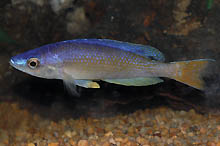
Cyprichromis
leptosoma is collected from many different places around the
lake. Often some types arrive and do not have a good reference photo to
view. Here is a blue body, yellow tail version from Karilani Island,
Tanzania.
|
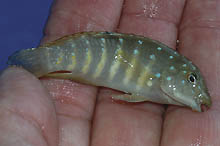
Collected in the extreme northern
Congolese coast around Makobola, Tanganicodus
irsacae has been exported again after many years. The fish
sports brighter colors than the normal fare from Burundi.
|
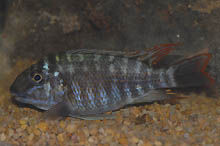
Several localized Petrochromis species are currently
sought by specialists. Here a Petrochromis
from southern Congo, called Longola, sports red finnage, cheek
striations, and delicate blue body markings. Only scant numbers are
exported each season.
|
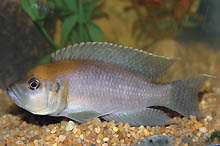
This new variety collected near Mpimbwe,
Tanzania, is perhaps a Lamprologus
calliurus. Noticeable is the gold head patch and gold ventral
markings absent in the normal form from the Zambian border.
|
Lake Malawi
Exporters from the Lake Malawi areas are suffering from the
current economic crisis as much as anyone. Some of the exporters have
closed up and are no longer collecting. There is no “must have” fish
from the list of export items. Thus most all wild caught varieties are
sold under tepid conditions. Hopefully, when the economic climate
improves, so will the sale of wild caught items from Malawi.
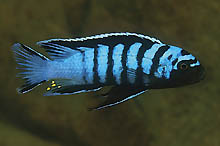
Hailing from Mara Rocks, Malawi, another
Cynotilapia afra
form has been recently found. This variety has a more elongated body
than most other C. afra found
elsewhere, thus perhaps it will later be described as a different
species. Photo by A. Konings. |
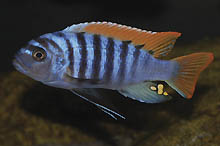
Many Malawi cichlid hobbyists are
turning to the classical species from times past. Metriaclima pyrsonotos, formerly
know as Red Top Zebra, is one such fish which has found new popularity
and was first exported in the 1970s. |
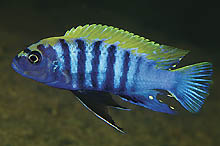
Over the last couple of years, C. afra varieties have been popular
among Malawi cichlid fans. Here the C.
afra from Nkhata Bay, Malawi sports a brilliant yellow head
blaze and was formerly sold as an “edwardi” type. Other yellow blaze
types of afra are found in a few other locals around the lake. Photo by
A. Konings. |
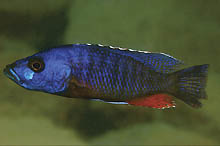
Larger predatory cichlids from Malawi
have also gained interest. Many of these species have beautifully
colored males. Here a Stigmatochromis
modestus (first exported 15 years ago) still has good demand
especially when available as small bred items. Photo by A.
Konings. |
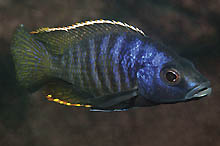
Recently described as Otopharnyx spelaeotes, this fish
used to by sold as Stigmatochromis King Cave from Malawi. This
interesting cichlid is usually found in cave-like structures on the
east coast and is rarely exported. Photo by A. Konings. |
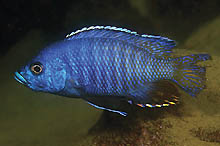
Another recently described cichlid from
Malawi is Otopharnyx antron,
formerly known as Stigmatochromis
sp. “modestus eastern”. As far as I know, the fish has never been
exported for the aquarium hobby. Photo by A. Konings. |
West Africa
Sales of wild caught West African items are down somewhat;
also suffering from the current economic decline. Some exporters are
changing their species lists to reflect hard-to-find items. Some export
prices are being re-adjusted to help with sales although freight costs
continue to rise. Thus fans of certain rarely seen fish may be
pleasantly surprised.
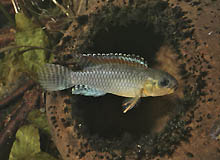
Exported infrequently in the recent
past, Congochromis dimidiatus
is now available from Kinshasa exporters. This dwarf cichlid is usually
erroneously sold as Nanochromis dimidiatus. Photo by O. Lucanus. |
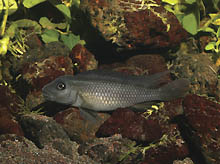
Often mixed among the normal buffalohead
species, Steatocranus casuarius,
this species is distinguishable by its body shape and is now sold as S. gibbiceps. It displays blue
lines when they are older. Photo by O. Lucanus. |
Neotropics
Recent developments with the Brazilian government and
exporters have been reported. Several exporters were arrested in a wide
sweep by the Brazil government to stop the flow of restricted fish.
Certainly the actual culprits were only a few, but this served as a
wake-up call to those who ignore the regulations. Hopefully this will
not negatively affect the normal exports from that country for
long.
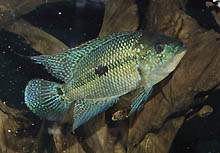
Rare collections and exports of Caquetaia umbrifera from Columbia
and Panama make this fish a difficult item to find. The blue “umbie” is
one of the most impressive large cichlids from the new world. Photo by
O. Lucanus. |
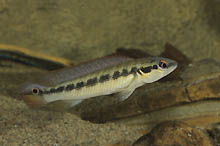
Only two species of Crenicichla are now allowed to be
sold from Brazil. Here C. stocki are
sometimes mixed by accident with C.
alta (allowed) in shipments as they are difficult to tell apart
when small. Photo by O. Lucanus. |
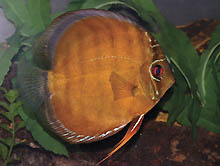
Several wild “brown” discus varieties
are exported from Brazil. Sold as red Tucurui and exported from Belem,
this discus displays red markings in its anal fin area along with red
in its ventral fins.
|
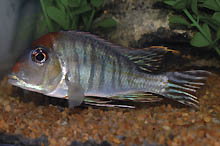
Fortunately several Geophagus species are allowed to be
exported from Brazil. Here a colorful red head form arrived from the
Tocantins area near Belem. There are several red head Geophagus varieties from this area.
|
Select date in side bar to go a What's
New of previous issues
|















